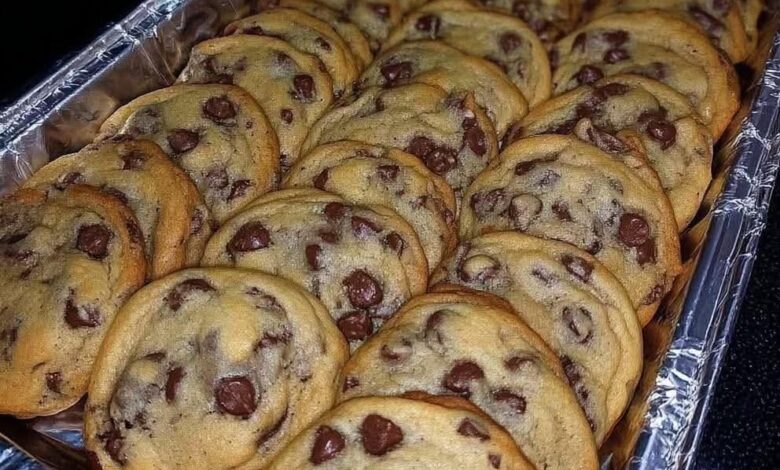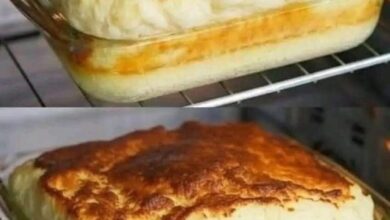The Best Chocolate Chip Cookies

Here is a richly detailed guide to The Best Chocolate Chip Cookies — covering everything from history and tips to full instructions, nutritional info, and a health‑minded conclusion. You can adapt quantities or ingredients as needed to your taste or dietary preferences.
Introduction & Description
- Chocolate chip cookies are one of the quintessential comfort‑foods: crisp along the edges, soft and chewy in the center, with warm pockets of melted chocolate in every bite. A well-made chocolate chip cookie is nostalgic, universally loved, and endlessly adaptable — crisp or gooey, classic or loaded with mix-ins.
In this guide, “best” means balanced texture (slightly crisp edges + soft interior), great flavor, and reliable results. You’ll find a tried‑and‑true recipe, variations, and tips to make these cookies shine.
Origin & Cultural Significance
- The chocolate chip cookie is widely credited to Ruth Graves Wakefield in 1938, who while running the Toll House Inn in Whitman, Massachusetts, chopped up a semi‑sweet chocolate bar and mixed the pieces into cookie dough. She didn’t expect them to stay as chunks instead of fully melting — but they did, and the recipe became very popular.
- Wakefield licensed the recipe to Nestlé, which printed it on chocolate chip packaging, helping spread the cookie’s fame.
- Over time, the chocolate chip cookie has become an icon in American baking—and around the world it is one of the most beloved cookies, with countless local variations, “best cookie” contests, and cultural references (in films, baking competitions, cafés, etc.).
- It represents home baking, childhood treats, and the pleasure of combining simple ingredients into something delightful.
Because of its simplicity, the chocolate chip cookie is also often a “gateway” baking recipe — a way beginners learn techniques like creaming butter and sugar, proper dough hydration, and managing bake times.
Ingredients & Quantities
Here is a reliable baseline recipe, making about 24–30 medium cookies (depending on size).
| Ingredient | Quantity |
|---|---|
| Unsalted butter, softened (or partially browned) | 113 g (½ cup) |
| Granulated sugar | 100 g (½ cup) |
| Light brown sugar (packed) | 110 g (½ cup + 2 Tbsp) |
| Large egg | 1 |
| Egg yolk (extra) | 1 |
| Vanilla extract | 1½ tsp |
| All‑purpose flour | 225 g (1¾ cups) |
| Baking soda | ½ tsp |
| Salt | ½ tsp |
| Chocolate chips or chunks (semisweet) | 170–200 g (1 to 1⅓ cups) |
Notes / rationale:
- Using both granulated sugar + brown sugar gives a balance: brown sugar (with its molasses content) helps with moist chewiness; granulated sugar helps with spread and crispness.
- The extra egg yolk adds richness and chew without making the dough too loose.
- The ratio of butter to flour is moderate; you could slightly adjust for a softer vs crisper cookie.
- Good quality chocolate (chips or chopped bars) makes a big difference in flavor.
- If you want a “brown butter” version, you can brown part or all of the butter to add nutty depth (many “best cookie” recipes use browned butter).
Optional Additions & Variations
You can tweak or expand the base recipe to suit your preferences:
- Nuts: chopped walnuts, pecans, almonds (25–50 g)
- Oats: substitute up to ¼ of the flour with rolled oats for texture
- Sea salt flakes: a pinch on top just before baking
- Mixed chocolates: use dark, milk, white chocolate chips or chunks for variety
- Toffee bits, peanut butter chips, M&Ms, coconut — anything you enjoy
- Whole wheat or whole wheat pastry flour: replace up to 25–50% of the flour for added fiber (expect texture changes)
- Vegan / egg‑free: use plant butter + flax egg or commercial egg replacer + vegan chocolate
- Less sugar: reduce each sugar by 10–20% (test scale) — cookies may be less sweet but still enjoyable
- Chill time: refrigerate dough for 1–24 hours to improve flavor and prevent over‑spread
Tips for Success
- Weigh your ingredients — especially flour — for consistency. Scooping flour can compress it and lead to too much, making dry cookies.
- Don’t over‑cream butter & sugar — cream just until light and fluffy; overdoing it can cause too much air and collapse later.
- Chill the dough — even 30 minutes helps; overnight is even better (improves texture and flavor).
- Use parchment or silicone mats to prevent sticking and promote even bake.
- Space cookies well — give room for spread, usually ~2 inches apart.
- Rotate pans mid-bake to account for oven hot spots.
- Bake just until edges are set — centers may still look slightly underdone; they continue to cook as they cool.
- Let cool on the baking sheet for a few minutes before transferring to wire rack (to let them firm up).
- For chewier cookies, slightly underbake (remove earlier). For crisper, bake a bit longer (watch carefully).
- Use quality vanilla and chocolate — they significantly influence flavor.
Instructions (Step by Step)
- Preheat your oven to 175 °C (350 °F). Line baking sheets with parchment or silicone mats.
- In a mixing bowl, cream together the softened butter, granulated sugar, and brown sugar until light and fluffy (about 2–3 minutes).
- Add the egg, extra yolk, and vanilla extract; beat until combined.
- In a separate bowl, whisk together the flour, baking soda, and salt.
- Gradually incorporate the dry ingredients into the wet mixture, mixing until just combined (don’t overmix).
- Fold in the chocolate chips / chunks (and any optional add‑ins).
- (Optional but recommended) Chill the dough in the refrigerator for at least 30 minutes, up to overnight.
- Use a cookie scoop or tablespoon to portion dough balls (≈ 30 g each for medium cookies). Place them ~5 cm (2 in) apart on your prepared sheets.
- Bake for 9–12 minutes, or until edges are golden and centers are just set (a bit soft is okay). If making larger cookies, add a few extra minutes.
- Remove from oven, let them sit on the baking sheet 2 minutes, then move to wire rack to cool completely.
Nutritional Information (Estimate)
Here is a rough estimate per cookie (based on about 24 cookies per batch):
| Nutrient | Amount |
|---|---|
| Calories | ~180–220 kcal |
| Total Fat | ~9–12 g (of which saturated fat ~5–6 g) |
| Carbohydrates | ~25–30 g (sugars ~15–20 g) |
| Protein | ~2–3 g |
| Fiber | ~1 g (depending on flour or add‑ins) |
| Sodium | ~120–150 mg (from salt + baking soda) |
These are ballpark values; actual nutrition will vary based on your ingredients, sizes, and add‑ins. Commercial cookie products often have dense calorie and fat content (e.g. ~170 kcal per 39 g cookie) .
Conclusion & Recommendation
These chocolate chip cookies strike a pleasing balance between crisp edges and soft, chewy centers. They aren’t overly sweet but have enough sugar and chocolate to satisfy cravings. With the optional chill time and high quality ingredients (butter, vanilla, chocolate), you’ll elevate them from “just cookies” to something you’ll look forward to baking and sharing.
If you make this base recipe, try one variation—say, fold in nuts or use half chopped chocolate bars instead of chips. Observe how it changes the texture and flavor. Over time, you’ll develop your own “best” version.
Embracing Healthful Indulgence
While classic chocolate chip cookies are undeniably indulgent, here are ways to enjoy them more mindfully:
- Portion control: savor one or two rather than the whole batch.
- Healthier tweaks: use high-percentage dark chocolate, replace part of the flour with whole grain or oat flour, reduce sugar by 10–20%, or use natural sweeteners.
- Add fiber or nutrients: include chopped nuts, seeds, or oats.
- Balance with meals: pair a cookie with a protein (e.g. yogurt or nuts) to slow sugar absorption.
- Mindful eating: enjoy slowly, focusing on flavor and texture, rather than “mindlessly snacking.”
- Occasional treat: keep these reserved for special occasions or weekend baking, rather than daily habit.
When made with intention and shared with others, chocolate chip cookies can be a joyful treat rather than a guilty one.
If you like, I can convert this recipe into metric units or suggest a lower sugar version — do you want me to do that?



